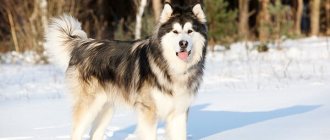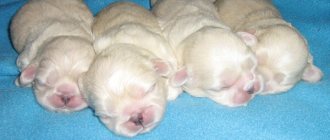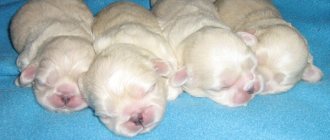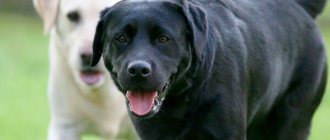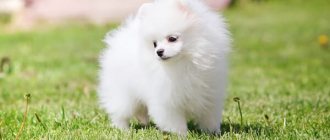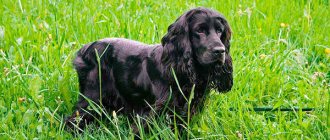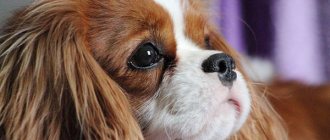Do dwarf Pekingese exist and what do they look like in the photo?
The existence of dwarf Pekingese is not a myth. Indeed, among the representatives of this breed there are miniature individuals, which are also called sleeve (pocket) or mini Pekingese.
These dogs are not an independent breed, but only a variation of it. Dwarf Pekingese can be born in a litter of standard-sized dogs; moreover, among mini Pekingese, only males can be bred; females should not be bred, since there is a high risk of their death during childbirth.
However, some breeders claim that the Mini Pekingese is distinguished by a more playful character and sharp mind than the standard representatives of the breed.
NOTE!
You can determine from a puppy what type of puppy it will grow up to be - standard or pocket - only when it reaches 8 months.
How did you appear?
Pekingese come from China, where for a long time they were considered almost sacred animals, which, judging by beliefs and legends, brought happiness and prosperity to the house.
Only rulers and people close to them could keep these dogs, so Pekingese always lived in palaces and received all kinds of honors and the best care, even having their own servants.
Despite the compact size of the Pekingese, it was quite difficult for the court ladies to care for them and carry them everywhere in their arms, so the royal nobility decided to breed an even smaller variety of the breed - tiny Pekingese weighing less than 3 kg.
However, it was not possible to consolidate such height and weight indicators in the Pekingese. It was not even possible to predict the birth of such individuals - they appeared in the litter of standard dogs.
In addition, their extremely miniature size has caused many health problems, including improper development of the skeletal system, so today such individuals are considered rather a defect in the breed and are not allowed for exhibitions and breeding, which, however, does not reduce the demand for them.
The breed standard for dwarf Pekingese is currently being developed in the UK; it is known that the maximum permissible weight for them is 3 kg, and according to cynologists in Canada and the USA - no more than 2.7 kg.
Pekingese or Japanese Chin?
What are the differences between the Pekingese and the Japanese Chin? Previously, these small fluffy dogs were often confused. Their appearance is associated with China and Buddhist religious customs. In their appearance, they are somewhat similar to a lion, which is a sacred animal in this religion.
Therefore, they were given magnificent honors. Commoners were not even allowed to look at the dog. They were brought to Europe in 1860 . And since then, the Pekingese has found its place everywhere. If you look at the profile of this dog, you can see that it has a snub nose.
color can be varied, but the most standard is fawn, red and all their shades. It also comes in two colors or different shades at the same time. The eyes have a bright black “rim ”.
Important! Her nose is black, flattened, and is in line with her eyes. The paws are short and round. The main beauty of a dog is its fur. It is long, silky, very lush on the nape and neck. It does not adhere to the body and requires special grooming - comprehensive care for the dog.
The Japanese Chin is also a miniature dog. Usually the weight of these dogs is up to 3 kg or more. Those weighing up to 3 kg are especially welcome. Chins were also considered to belong to emperors, only in Japan.
They, like the Pekingese, were worshiped. They came to Europe from England (a couple of chins were given to Queen Victoria). But they were still inferior in popularity to the Pekingese. These are playful dogs with their inherent majesty and indomitability.
Although they have a large head , it corresponds to the size of the body. The dog's forehead protrudes forward, and its eyes are bulging , large, and dark in color, set wide apart. The tail is especially remarkable.
It is thrown over the back in such a way that the fur flows beautifully from it. The most popular dog color is white with black or red spots of a certain pattern. As you can see, both of these breeds have a lot in common. Perhaps it was true that they had a common ancestor?
Important! The standard clearly defines the proportions, size, character and other parameters of the Pekingese. Therefore, there are no imperial, dwarf, royal, lion, Chinese or other varieties of this wonderful dog.
Character traits
The Dwarf Pekingese has a calm character and is characterized by a lack of aggression and fearlessness.
These dogs quickly become attached to the owner and need his attention, but they will never impose themselves, because they are quite independent and have the ability to capture his mood, understanding when it is better to stay away.
Miniature representatives of the breed do not like long walks, noisy companies and active games, so they will become excellent pets for people accustomed to leading a measured and calm lifestyle.
Due to their dislike of noise and activity, the Miniature Pekingese is not the best option for families with small children. Such a pet will not only not be able to share the baby’s enthusiasm, but will also try to stay away from him.
They can get along with other pets only on the condition that the owner, no matter what, will pay maximum attention to them and not to other animals, otherwise aggression is possible, although it is not typical for these dogs.
Mini Pekingese are not easy to train. These dogs are smart, but too stubborn and willful, and a disrespectful attitude and, especially, physical punishment will lead to the opposite result and destructive behavior of the pet, so the owner should be patient and self-control.
Expert opinion
Kozhevin Semyon Kirillovich
Expert dog handler.
Pocket Pekingese can be described as intelligent and quick-witted, but also stubborn, headstrong, touchy and proud dogs. They need the attention, love and affection of their owner and, if they do not receive this, they begin to feel sad and fall into a kind of depression, which entails a refusal of water and food. We must not forget that Pekingese have long been accustomed to special treatment, so they can be quite selfish - for these dogs this character trait is quite normal.
Interesting Facts
Despite the fact that the history of the breed goes back several thousand years, interest in these dogs only grows over time. Here are some of the interesting facts:
- Initially, the Chinese called these dogs Fu. They received their modern name in England after the name of the Chinese capital - Beijing.
- In Ancient China, there was a belief that the Pekingese guarded the emperor in the afterlife, therefore, in the event of the death of the ruler, he was necessarily buried along with his pet.
- Residents of Ancient China believed that these cute dogs protected the home from dark forces and misfortunes.
- Noble Chinese ladies used dogs for self-defense. They fit easily into the sleeve of their owner's clothes. In case of danger, the dogs jumped out of the sleeve and rushed at the offender.
- The first exhibition Pekingese in 1894 at the Chester Exhibition in England was a dog named Peter.
- In Russia, the first Pekingese dogs appeared only in the 70s of the twentieth century.
Advantages and disadvantages
These little Pekingese, like representatives of other breeds, have their advantages and disadvantages.
So, the advantages of these dogs include:
- courage;
- calm disposition;
- lack of aggression;
- possibility of keeping even in a small apartment;
- devotion.
Disadvantages of Mini Pekingese:
- stubbornness;
- pride;
- difficulties in training;
- jealousy and resentment;
- heavy shedding;
- need for careful grooming.
IMPORTANT!
In addition, such a pet is not suitable for a family with small children.
Photo gallery
Pekingese are more suitable for those people who can pay a lot of attention to their pet. This dog is surprisingly good at understanding the mood of its owner. Let's take a look at these doggies in our photo selection below.
Dimensions, weight and other distinctive features
| Characteristic | Description |
| Height at withers | No more than 20 cm |
| Weight | Maximum 3 kg |
| Head | Wide, large relative to the body |
| Ears | Hanging, medium, close to the skull, slightly turned forward |
| Eyes | Round, large, slightly convex, brown iris |
| Forehead | Wide and flat |
| Nose | The back is recessed into the skull, the nose is turned up, at eye level |
| Tail | Set high, curled into a half ring |
| Coat | Long, straight, short and dense undercoat |
| Color | Black-red, fawn, golden, black, white |
Life expectancy and diseases
Dwarf Pekingese live on average 8-10 years.
At the same time, they cannot be called owners of good health, since they are prone to developing a number of diseases:
- eversion of eyelids;
- punctures and scratches in the cornea;
- cataract;
- heart attack;
- hemophilia;
- blepharitis;
- joint diseases;
- osteochondrosis;
- herniated intervertebral discs;
- non-overgrowth of the fontanelle;
- conjunctivitis;
- hydrocephalus.
In addition, the specific structure of the muzzle of these dogs causes frequent breathing problems. Thus, especially in winter, mini Pekingese are often diagnosed with laryngitis, bronchitis and tracheitis.
Choosing a nickname
These funny-looking animals are often called imperial names, which over time turn into short forms. Beautiful combinations are obtained with thematic adjectives. Double names are given to Pekingese for entry in the pedigree.
Nicknames for boys: Caesar, Tobby, Dandy, Johnny, Stitch, Max, Simba. Nicknames for girls: Mary, Nymph, Daisy, Prima, Bella, Basya, Fani.
Care and maintenance
Dwarf Pekingese are domestic dogs. Due to their compact size, they can live comfortably even in small city apartments, while street keeping is strictly prohibited.
Caring for these dogs is not difficult, but it must be done regularly, paying special attention to eye and coat care.
Wool and bathing
Comb every day using a slicker brush and a massage comb - this will avoid the formation of tangles and get rid of dead hair.
Mini Pekingese need to be bathed once a month, but after each walk, be sure to wash your pet’s paws and belly.
Haircuts are not necessary for these dogs, but they can make caring for their coat easier.
Ears
Inspect and clean weekly, removing accumulated wax and dirt, with a cotton pad soaked in a special product or 3% hydrogen peroxide solution.
Teeth
At least once a week, or better yet every 2-3 days, brush your pet’s teeth with a special brush and paste to minimize the likelihood of plaque and tartar formation.
Claws
Trim with a guillotine nail clipper as it grows, on average 1-2 times a month. Smooth the sharp edge with a nail file.
Eyes
Wipe your eyes daily with a lint-free cloth soaked in chamomile infusion or boiled water. This must be done carefully so as not to injure or irritate the cornea.
Proper feeding
It is necessary to ensure that the diet of dwarf Pekingese is balanced.
When feeding naturally, the diet should include:
- lean meat;
- offal;
- porridge;
- sea fish;
- fruits, vegetables and herbs;
- dairy products.
It is forbidden to feed mini Pekingese:
- potatoes and legumes;
- fatty meat;
- confectionery products;
- sausages;
- river fish;
- citrus fruits;
- strawberries;
- bones.
Liquid foods should be avoided because... Due to the structure of their muzzle, these dogs have difficulty eating it.
NOTE!
Foods should be cut into small pieces to make them easier for your pet to chew.
When feeding prepared foods, you must choose products of at least premium class. Such food has a balanced composition enriched with all necessary vitamins and minerals.
The most popular food brands among breeders are Acana, Happy Dog, Canidae, Orijen, Artemis, Almo Nature, Royal Canin, Brit Premium.
Price range
Since it is impossible to plan the birth of dwarf Pekingese, such dogs are very rare, which makes them quite expensive.
Prices for mini Pekingese start at 10 thousand rubles, and if the puppy is born from show-class dogs or champions, then its cost increases to at least 20 thousand rubles.
Origin story
The breed, as the name suggests, originates from Beijing. Dogs were mentioned in 2000 BC. e. According to legend, they protected the palace and the royal family from evil spirits. After the death of the owner, the dog was also subject to burial. The Chinese emperor had 5 dogs that lived in the women's half of the palace. No one except the royal family had the right to keep a dwarf Pekingese; this was punishable by death. The dogs had their own servants; if anything happened to the pet, the servants were executed.
The exact origin story is unknown. There are several versions, the most realistic is that the breed appeared through selective breeding. Pekingese were first brought to Europe in the 60s of the 19th century, thanks to the British who captured the Summer Palace. After this, the Royal Pekingese began to spread throughout the world.
How to choose a puppy?
The main thing you need to pay attention to when choosing a puppy is its health. The little Pekingese should be cheerful and active, not lag behind in development and not have any symptoms of pathology, such as skin rashes, increased lacrimation, unpleasant odor from the ears, nasal discharge, etc.
It is also important to ask the breeder about the availability of vaccinations and a veterinary passport, the timing of deworming, ask about the feeding of the puppy and the health and character of its parents.
IMPORTANT!
If we are talking about buying a pocket Pekingese, then this should be done no earlier than the puppy turns 8 months old - only at this age can you accurately determine how the pet will grow up - mini or standard.
Possible diseases
Mini dogs are prone to the same diseases as regular dogs.
The most common pathologies are:
- skin diseases,
- joint damage, paralysis,
- intervertebral hernia,
- bone fragility,
- tumor of the perianal glands,
- respiratory tract diseases (bronchitis, laryngitis, rhinitis),
- genitourinary diseases,
- breathing disorder,
- cardiac pathologies.
But the most sensitive organ is the eyes. The most common ailments are cataracts, ectropion, keratitis, and ulcers. A mandatory condition for health will be vaccination and quarterly examination by a specialist. The first vaccination is given at three months. Life expectancy, in this case, is about 14-16 years.
